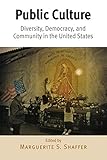Public Culture : Diversity, Democracy, and Community in the United States / ed. by Marguerite S. Shaffer.
Material type: TextPublisher: Philadelphia : University of Pennsylvania Press, [2012]Copyright date: ©2008Description: 1 online resource (392 p.) : 34 illusContent type:
TextPublisher: Philadelphia : University of Pennsylvania Press, [2012]Copyright date: ©2008Description: 1 online resource (392 p.) : 34 illusContent type: - 9780812222029
- 9780812206845
- Community life -- United States -- Congresses
- Cultural pluralism -- United States -- Congresses
- Democracy -- United States -- Congresses
- National characteristics, American -- Congresses
- Political culture -- United States -- Congresses
- Popular culture -- United States -- Congresses
- Public spaces -- United States -- Congresses
- American Studies
- HISTORY / United States / 20th Century
- American History
- American Studies
- Political Science
- 306.0973 22
- E169.1.P935 2012
- online - DeGruyter
- Issued also in print.
| Item type | Current library | Call number | URL | Status | Notes | Barcode | |
|---|---|---|---|---|---|---|---|
 eBook
eBook
|
Biblioteca "Angelicum" Pont. Univ. S.Tommaso d'Aquino Nuvola online | online - DeGruyter (Browse shelf(Opens below)) | Online access | Not for loan (Accesso limitato) | Accesso per gli utenti autorizzati / Access for authorized users | (dgr)9780812206845 |
Frontmatter -- Contents -- Preface. Why Public Culture? -- What Is Public Culture? Agency and Contested Meaning in American Culture-An Introduction -- PART I. Public Action -- Chapter 1. Looking for the Public in Time and Space: The Case of the Los Angeles Plaza from the Eighteenth Century to the Present -- Chapter 2. Remembrance, Contestation, Excavation: The Work of Memory in Oklahoma City, the Washita Battlefield, and the Tulsa Race Riot -- Chapter 3. Public Sentiments and the American Remembrance of World War II -- PART II. Public Image -- Chapter 4. Sponsorship and Snake Oil: Medicine Shows and Contemporary Public Culture -- Chapter 5. Entertainment Wars: Television Culture after 9/11 -- Chapter 6. Screening Pornography -- PART III. Public Space -- Chapter 7. The Billboard War: Gender, Commerce, and Public Space -- Chapter 8. The Social Space of Shopping: Mobilizing Dreams for Public Culture -- Chapter 9. Gates, Barriers, and the Rise of Affinity: Parsing Public-Private Space in Postindustrial America -- PART IV. Public Identity -- Chapter 10. To Serve the Living: The Public and Civic Identity of African American Funeral Directors -- Chapter 11. Denizenship as Transnational Practice -- Chapter 12. The Queen's Mirrors: Public Identity and the Process of Transformation in Cincinnati, Ohio -- Epilogue. Pitfalls and Promises: Whither the "Public" in America? -- Notes -- Contributors -- Index -- Acknowledgments
restricted access online access with authorization star
http://purl.org/coar/access_right/c_16ec
In the United States today many people are as likely to identify themselves by their ethnicity or region as by their nationality. In this country with its diversity and inequalities, can there be a shared public culture? Is there an unbridgeable gap between cultural variety and civic unity, or can public forms of expression provide an opportunity for Americans to come together as a people?In Public Culture: Diversity, Democracy, and Community in the United States, an interdisciplinary group of scholars addresses these questions while considering the state of American public culture over the past one hundred years. From medicine shows to the Internet, from the Los Angeles Plaza to the Las Vegas Strip, from the commemoration of the Oklahoma City bombing to television programming after 9/11, public sights and scenes provide ways to negotiate new forms of belonging in a diverse, postmodern community. By analyzing these cultural phenomena, the essays in this volume reveal how mass media, consumerism, increased privatization of space, and growing political polarization have transformed public culture and the very notion of the American public.Focusing on four central themes-public action, public image, public space, and public identity-and approaching shared culture from a range of disciplines-including mass communication, history, sociology, urban studies, ethnic studies, and cultural studies-Public Culture offers refreshing perspectives on a subject of perennial significance.
Issued also in print.
Mode of access: Internet via World Wide Web.
In English.
Description based on online resource; title from PDF title page (publisher's Web site, viewed 24. Apr 2022)


